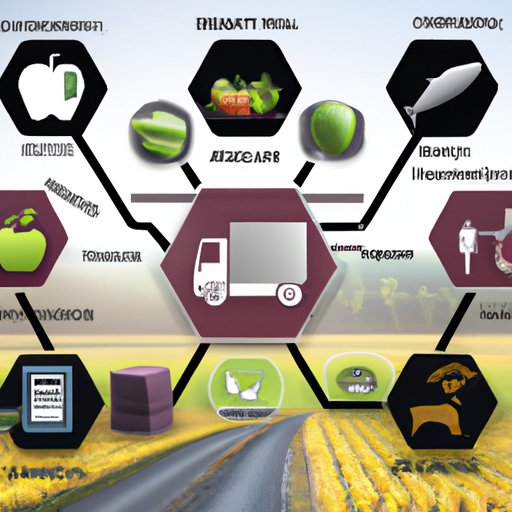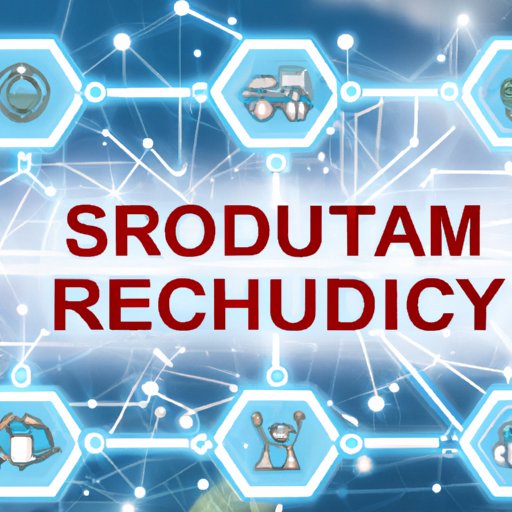Introduction
The food supply chain is a complex network of activities, processes and stakeholders responsible for getting food from the farm to our plate. It involves every step in the journey of food, from sourcing raw materials to processing, packaging and transporting them, as well as retailing and consuming them. The food supply chain is essential for ensuring a safe and reliable supply of food for the global population.

Overview of the Food Supply Chain
The food supply chain consists of four main stages: production, processing, distribution, and consumption. Production involves growing or raising the food, either through traditional farming or modern agricultural practices. Processing includes preparation, packaging, storage and transportation of food. Distribution involves moving the food from the producer to the consumer, usually through wholesalers, retailers, or distributors. Finally, consumption involves the actual sale and purchase of the food by the consumer.

Exploring the Different Stages of the Food Supply Chain
At each stage of the food supply chain, there are different companies and organizations involved. For example, producers may include farmers, fishermen, and ranchers. Processors may include food manufacturers, packagers, and distributors. Wholesalers and retailers are responsible for distributing the food to consumers. Finally, consumers are the end users who purchase and consume the food.

How Technology is Changing the Way We Manage the Food Supply Chain
Technology is revolutionizing the way we manage the food supply chain. Automation and digitalization are making it easier to track and monitor food throughout the supply chain. For example, sensors can be used to monitor temperatures in order to ensure food safety and quality. Data collected from these sensors can then be used to optimize processes and improve efficiency.
In addition, the use of artificial intelligence (AI) and machine learning algorithms can help identify trends in the data and make predictions about future demand. This can enable companies to better manage their inventory and reduce waste. Finally, blockchain technology can provide a secure and transparent way to track and trace food products as they move through the supply chain.
What are the Benefits of a Well-Functioning Food Supply Chain?
A well-functioning food supply chain has numerous benefits. First and foremost, it increases efficiency by reducing the time it takes for food to get from the producer to the consumer. This can lead to cost savings for both producers and consumers. Additionally, a well-functioning food supply chain increases transparency by providing greater visibility into the provenance of food products, which can help to ensure that food is safe and of high quality.
The Impact of Globalization on the Food Supply Chain
Globalization has had a major impact on the food supply chain. As international trade has increased, so has the demand for food. This has created a need for more efficient and effective supply chains to meet this demand. However, globalization has also presented challenges, such as the need for more stringent food safety regulations and the increasing complexity of logistics due to longer distances and multiple countries involved.
Examining Factors that Influence the Efficiency of the Food Supply Chain
There are several factors that influence the efficiency of the food supply chain. Logistical considerations, such as infrastructure and transportation networks, can have a significant impact on the speed and cost of moving food from one location to another. Quality control measures must be taken to ensure that food is safe and of high quality. Finally, government regulations can have an effect on the efficiency of the food supply chain, particularly when it comes to food safety and labeling requirements.
Innovative Solutions to Improve the Food Supply Chain
There are a number of innovative solutions being developed to improve the food supply chain. Blockchain technology can be used to create a secure and transparent system for tracking food throughout the supply chain. Artificial intelligence can be used to automate processes and make predictions about future demand. Finally, cloud computing can provide a platform for data sharing and analysis, enabling companies to better manage their operations.
Conclusion
The food supply chain is an essential part of the global food system, providing a safe and reliable supply of food for the world’s population. Technology is transforming the way we manage the food supply chain, with automation, digitalization, and data analytics leading to improved efficiency and reduced costs. Globalization has increased the demand for food, while creating challenges associated with global trade. Finally, innovative solutions such as blockchain technology, artificial intelligence, and cloud computing are being developed to improve the efficiency of the food supply chain.
(Note: Is this article not meeting your expectations? Do you have knowledge or insights to share? Unlock new opportunities and expand your reach by joining our authors team. Click Registration to join us and share your expertise with our readers.)
